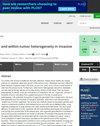HGCLAMIR: Hypergraph contrastive learning with attention mechanism and integrated multi-view representation for predicting miRNA-disease associations
IF 3.6
2区 生物学
引用次数: 0
Abstract
Existing studies have shown that the abnormal expression of microRNAs (miRNAs) usually leads to the occurrence and development of human diseases. Identifying disease-related miRNAs contributes to studying the pathogenesis of diseases at the molecular level. As traditional biological experiments are time-consuming and expensive, computational methods have been used as an effective complement to infer the potential associations between miRNAs and diseases. However, most of the existing computational methods still face three main challenges: (i) learning of high-order relations; (ii) insufficient representation learning ability; (iii) importance learning and integration of multi-view embedding representation. To this end, we developed a HyperGraph Contrastive Learning with view-aware Attention Mechanism and Integrated multi-view Representation (HGCLAMIR) model to discover potential miRNA-disease associations. First, hypergraph convolutional network (HGCN) was utilized to capture high-order complex relations from hypergraphs related to miRNAs and diseases. Then, we combined HGCN with contrastive learning to improve and enhance the embedded representation learning ability of HGCN. Moreover, we introduced view-aware attention mechanism to adaptively weight the embedded representations of different views, thereby obtaining the importance of multi-view latent representations. Next, we innovatively proposed integrated representation learning to integrate the embedded representation information of multiple views for obtaining more reasonable embedding information. Finally, the integrated representation information was fed into a neural network-based matrix completion method to perform miRNA-disease association prediction. Experimental results on the cross-validation set and independent test set indicated that HGCLAMIR can achieve better prediction performance than other baseline models. Furthermore, the results of case studies and enrichment analysis further demonstrated the accuracy of HGCLAMIR and unconfirmed potential associations had biological significance.HGCLAMIR:具有注意力机制和综合多视图表示的超图对比学习,用于预测 miRNA 与疾病的联系
现有研究表明,微RNA(miRNA)的异常表达通常会导致人类疾病的发生和发展。鉴定与疾病相关的 miRNAs 有助于从分子水平研究疾病的发病机理。由于传统的生物学实验耗时且昂贵,计算方法已被用作推断 miRNA 与疾病之间潜在关联的有效补充。然而,现有的大多数计算方法仍面临三大挑战:(1)高阶关系学习;(2)表征学习能力不足;(3)多视图嵌入表征的重要性学习与整合。为此,我们开发了一种具有视图感知注意机制和集成多视图表示的超图对比学习(HGCLAMIR)模型来发现潜在的 miRNA 与疾病的关联。首先,我们利用超图卷积网络(HGCN)从与 miRNA 和疾病相关的超图中捕捉高阶复杂关系。然后,我们将超图卷积网络与对比学习相结合,改进并提高了超图卷积网络的嵌入式表征学习能力。此外,我们还引入了视图感知注意机制,对不同视图的嵌入表征进行自适应加权,从而获得多视图潜在表征的重要性。接着,我们创新性地提出了整合表征学习,将多个视图的嵌入表征信息进行整合,从而获得更合理的嵌入信息。最后,将整合后的表征信息输入基于神经网络的矩阵补全方法,进行 miRNA 与疾病的关联预测。交叉验证集和独立测试集的实验结果表明,HGCLAMIR 比其他基线模型具有更好的预测性能。此外,案例研究和富集分析的结果也进一步证明了 HGCLAMIR 的准确性,未证实的潜在关联具有生物学意义。
本文章由计算机程序翻译,如有差异,请以英文原文为准。
求助全文
约1分钟内获得全文
求助全文
来源期刊

PLoS Computational Biology
生物-生化研究方法
CiteScore
7.10
自引率
4.70%
发文量
820
期刊介绍:
PLOS Computational Biology features works of exceptional significance that further our understanding of living systems at all scales—from molecules and cells, to patient populations and ecosystems—through the application of computational methods. Readers include life and computational scientists, who can take the important findings presented here to the next level of discovery.
Research articles must be declared as belonging to a relevant section. More information about the sections can be found in the submission guidelines.
Research articles should model aspects of biological systems, demonstrate both methodological and scientific novelty, and provide profound new biological insights.
Generally, reliability and significance of biological discovery through computation should be validated and enriched by experimental studies. Inclusion of experimental validation is not required for publication, but should be referenced where possible. Inclusion of experimental validation of a modest biological discovery through computation does not render a manuscript suitable for PLOS Computational Biology.
Research articles specifically designated as Methods papers should describe outstanding methods of exceptional importance that have been shown, or have the promise to provide new biological insights. The method must already be widely adopted, or have the promise of wide adoption by a broad community of users. Enhancements to existing published methods will only be considered if those enhancements bring exceptional new capabilities.
 求助内容:
求助内容: 应助结果提醒方式:
应助结果提醒方式:


